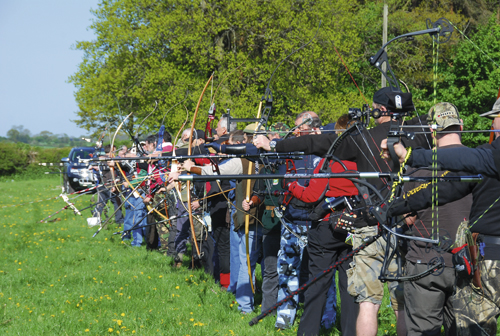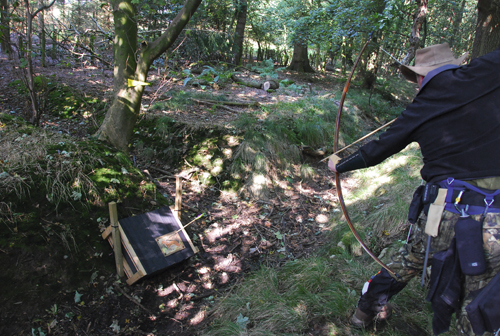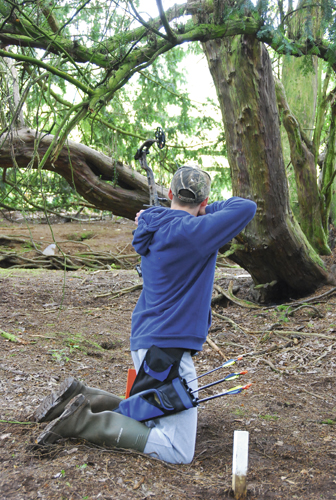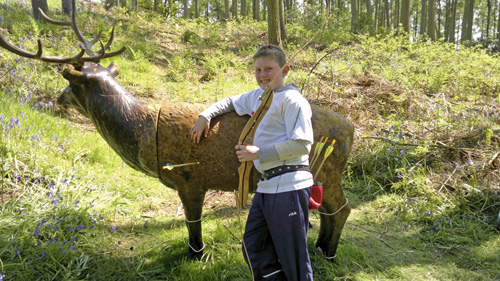If you’re interested in trying field archery – whether experienced target archer or complete beginner – Alex Tyler has the advice you need to get started
Archery has had an incredible amount of publicity over the last couple of years. The Olympics showed that it can be both television-friendly and very dramatic, while Hollywood has produced a series of bow-wielding heroes and heroines that have introduced the sport to new audiences, particularly young women. Gratifyingly, this higher profile has translated into an increase in people wanting to try archery, and Archery GB, the national body in the UK, reached 40,000 members in June 2013. While the type of archery depicted on screen may not correspond much with reality (the world being thankfully free of orcs) the closest approximation is field archery, with its emphasis on shooting in natural terrain.
For someone that has not tried archery before, the prospect can be daunting. Given the potential range of equipment, there is no substitute for an introduction from a club to teach the principles of safe shooting. There are three options available for those wishing to get into field archery in the UK, through Archery GB (which shoots FITA field rounds), the English Field Archery Association (EFAA) and National Field Archery Society (NFAS), and links to club websites for more information are below. Each society has its own rules, rounds, and styles, and each requires membership before shooting, for insurance purposes.

Many different bow styles shoot field archery, and joining a club will let you try out different equipment to see what you prefer
Some clubs offer formal beginners’ courses, but all clubs will have officers and members who can offer advice and support. A club can also let you experiment and try out different bow styles, to support the decision of what bow to buy. Although a lot of archery equipment can be bought via the internet if no specialist shop is available locally, there are dangers to buying without advice. As an example, no UK archery association permits the use of a cocking aid with a crossbow, so anyone purchasing a bow over a certain poundage would not be able to use it to take part in shoots.
My own experience began at a craft fair, where the local target archery club were offering a ‘have-a-go’ session. Having never tried archery before, I joined one of their beginners’ courses and decided to take it up. Having been able to explore different bow types through the club’s equipment, I chose English longbow as my style. Three months after joining, I helped my club to put on a field shoot. As I banged in stakes for these peculiarly-shaped targets and tried to work out how to judge the distances, I was convinced that I wouldn’t hit a thing. By the end of the shoot (having hit about 50 per cent of the targets), my longbow and I felt so at home in the woods that I joined NFAS. When I do go back to target archery, I appreciate the discipline and the focus upon maintaining the best technique, but enjoy the variety and more relaxed atmosphere of field archery. This was summed up for me in some advice I received on my second ever shoot: “First, worry about going around a field course without losing or breaking any arrows. When you can do that consistently, then go round without blanking anything. Only then, start worrying about your score.” It encouraged me to focus on developing my skills step-by-step, rather than expecting instant results.
If you are already familiar with target archery and are looking to try out field archery, it is possible to have an experience close to target archery with roundel targets of varying sizes at pre-determined, marked distances through FITA and EFAA. However, you still have to be prepared for the additional challenges of rough terrain and the likelihood that course-layers can set targets up or down hills or requiring a non-standard stance. You will be with a mixed group, taking it in turns to shoot. Another feature of field archery is the use of animal targets, either as paper faces or as life-size 3Ds, ranging from a rabbit to an elk. This means that the archer has to judge the size of the target and is shooting at an irregularly-shaped scoring zone. For additional challenge, the National Field Archery Society (NFAS) shoots only unmarked distances and shooting lanes do not need to be clear from obstructions. To participate in an NFAS open shoot, all new archers, even if they are members of other archery associations, need to be signed off by a coach or club official before they are allowed to become a full member. This is to ensure that all archers understand the safe rules of field shooting.
Someone who began as a target archer and now enjoys success at both target and field archery is Joe Fairburn of Yorkshire. Inspired by the Robin Hood TV show (starring Jonas Armstrong shooting a longbow that was distinctly recurved), Joe took up target archery in 2007 (aged five and a half) and was winning at county level by 2008. Fellow archers suggested that he give field a try, and a chance visit to a field course during a family holiday led to Joe joining a local field archery club when he got home.
Although Joe shoots Olympic recurve at his target club, in the woods, he decided to shoot Hunting Tackle (recurve bow), which meant losing his stabiliser and sight, and moving from metal to wooden arrows. “I didn’t want to lug so much equipment around the woods,” Joe explains. Losing the sight helped to develop instinctive skills, but he still remembers the first advice he was given, which was to “start with targets close and work back”, which helped to develop his confidence in the unfamiliar terrain of a wood.
Shooting field also helps his target archery. “When I am shooting target now, it is easier to focus,” said Joe. “You don’t have to worry about the ground not being flat or obstacles in the way, so you can just concentrate on shooting. Also, because field archery targets are smaller, it means you zoom in on a tighter area of the boss.” After winning eight field championships in two years (across NFAS and FITA disciplines), Joe has some potentially surprising advice for anyone looking to try field. “Use your best arrows, because you know how they shoot and that consistency is really important in field archery.” I didn’t ask Joe’s father Colin (who buys Joe’s arrows) whether he agrees with this…
Club listing websites:
National Field Archery Scoiety: www.nfas.net
English Field Archery Association: www.efaafieldarcher.com
Grand National Archery Society Field: www.gnasfield.co.uk





NICE! I totally wish they had something like this in the central Texas area!